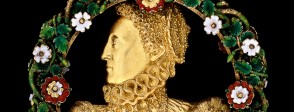Before using the Phoenix Jewel you could ask students to examine a collection of coins and banknotes which feature the head of the queen today. What message or image of the monarch is being portrayed? Students could then analyse some photographs of Queen Elizabeth II from the internet. How do these images compare with the queen’s portrait on the coins and banknotes? Ask students to list all the different ways in which the image of the queen is communicated today. Then ask them to speculate about who would have seen the image of Elizabeth I and how.
Engage interest in the Phoenix Jewel by telling students about the importance of jewels to Elizabeth I, explaining that hardly any items from the queen’s jewellery collection survive because most were sold or given as gifts by James I and Charles I. Using the images of the front and back of the Phoenix Jewel in For the classroom, ask students to examine the jewel carefully and to comment on the way in which the queen was portrayed.
Explain the symbolism of the phoenix. Why do students think that Elizabeth would have been particularly pleased with the Phoenix Jewel? Look at the portrait of Elizabeth wearing a phoenix jewel in For the classroom. Then compare the depiction of Elizabeth on the silver medal in A bigger picture. Use the information in the link to discuss why she is shown in much simpler costume and how the phoenix has changed in meaning.
The phoenix was not the only symbol used by artists portraying Elizabeth. Look at the reverse of the gold medal by Hilliard in A bigger picture and discuss how the symbol of the laurel tree has been used. This could extend to a wider enquiry on Elizabethan symbols.
Tell students that we don’t know for certain who made the Phoenix Jewel, but that some scholars have suggested it was designed by Nicholas Hilliard. Ask pupils to compare the Phoenix Jewel with other work by Nicholas Hilliard in A bigger picture and For the classroom. Do students think that the Phoenix Jewel is Hilliard’s work?
The Phoenix Jewel could provide the initial stimulus for enquiries that focus on very different aspects of the late sixteenth century.
How did Elizabeth I show her power?
This is perhaps the most obvious line of enquiry relating to the Phoenix Jewel. Following the specific activities based on the jewel described above, students could broaden their study by analysing the other images of Elizabeth in A Bigger Picture. Begin by asking students to consider the images of Elizabeth’s depicted by Nicholas Hilliard in the AD 1570s, then develop the enquiry by considering other images of Elizabeth from the 1580s and 1590s and in 1601.
The National Portrait Gallery link in For the classroom will provide a number of other portraits for students to use. Ask students to consider similarities and differences in the ways in which the queen was represented. Students could then research other ways in which the queen expressed her power: court ritual and spectacles, progresses, palaces, her relationship with Parliament and the English claim to North America. Students could work in role as researchers for a new TV documentary ‘The Power of Elizabeth I’. They could decide which artefacts, images and buildings to use in the documentary and could write the script for the presenter.
What mattered to Elizabethan people?
This enquiry focuses on the possessions of Elizabethan people and what they reveal about the attitudes and beliefs of their owners. The Phoenix Jewel could be the starting point. Students could consider what the jewelry, paintings and other items in A bigger picture reveal about the queen’s concerns. They could then broaden their research to include clothes, books, maps, documents, furniture and plate. Develop their enquiry by finding out about the material world of the Elizabethan nobility and gentry. What can students infer about the concerns of the nobility and gentry from their houses and possessions? Finally students can research the lives of the common people through their houses and artefacts. The apprentice cap in For the classroom would be a good starting point and the clips from Ian Mortimer’s TV series provide additional context. You could ask students to work as museum curators, selecting artefacts and images for an exhibition and writing panel text for the queen, the nobility and gentry and the common people.
What did Elizabeth and Akbar have in common?
The reign of the Mughal emperor Akbar (1556 – 1605) coincided almost precisely with that of Elizabeth I. Whereas Elizabeth’s subjects numbered around 3 million, Akbar ruled over around 100 million people. The first official contact between England and the Mughal empire came in 1583 when Ralph Fitch, a London merchant, travelled to Akbar’s court in Agra carrying a letter to the emperor from Elizabeth. A comparison of the two rulers would make an interesting enquiry. Students could begin by comparing the representations of the two rulers before researching different aspects of their power. The British Museum’s Mughal India website in For the classroom contains useful resources on Akbar and the Mughal empire.


